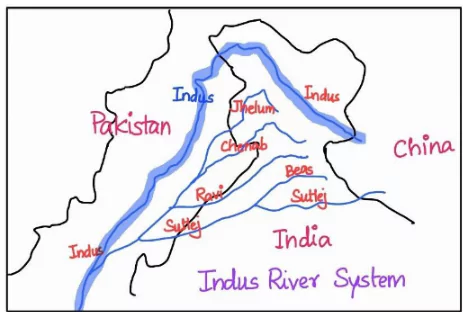The Indus River, also known as Sindhu, starts from the glaciers near the Kailash Mountain range in Tibet. It flows through India and Pakistan, playing a key role in the region’s geography and culture. With its tributaries, it nourishes vast areas, including Leh in India and Karachi in Pakistan.
An Overview of Indus River System: Origin
- From ‘Sindhu’ to ‘Singi Khamban: It is also known as the Sindhu; represents the western most of the Himalayan rivers in India.
 In the Tibetan region, it is referred to as ‘Singi Khamban’ or Lion’s mouth.
In the Tibetan region, it is referred to as ‘Singi Khamban’ or Lion’s mouth.
- Origin: Glacier near Bokhar Chu (Kailash Mountain range, Tibetan region)
- Area in India: A little over a third of the Indus basin is located in India.
- Leh is situated on the bank of Indus.
- Indus River’s Route: Flows between the Ladakh and Zanskar ranges and passes through Ladakh, Baltistan and Gilgit.
- It cuts across the Ladakh range, forming a gorge near Gilgit & enters Pakistan in the Dardistan region.
- Flows southward and receives ‘Panjnad’ (Satluj, the Beas, the Ravi, the Chenab and the Jhelum) near Mithankot (Pakistan).
- Discharges into the Arabian Sea, east of Karachi.
- Tributaries in Kasmir: Zanskar, the Nubra, the Shyok and the Hunza, join it in the Kashmir region.
Enroll now for UPSC Online Course
- Jhelum and Ravi joins Chenab; Beas joins Sutlej; Sutlej and Chenab joins and then merges with Indus [UPSC 2021]
|
Tributaries of the Indus River
-
Right Bank Tributaries:
- Shyok (origin -Siachen Glacier); Hunza; Gilgit (Last tributary in India); Khurram, Tochi, Gomal, Viboa and Sangar (all originate in the Sulaiman ranges); and Kabul.
- Shyok River: drains the northern Karakoram mountains and is joined by a major tributary, the Nubra (Origin: Siachen glacier)river from the north, and the combined course of the two rivers enters the Pak-occupied Kashmir
-
Left bank tributaries
- Jhelum: is known as Vyeth in Kashmiri, Vetesta in Sanskrit and Hydaspes in Greek.
- Origin: A spring in Verinag, located at the southeastern part of the Kashmir Valley, near the foot of the Pir Panjal mountain range.
- Traverses through Srinagar and the Wular Lake. [UPSC 2023]
- Enters Pakistan near Baramulla and meets the Chenab near Jhang in Pakistan.
- Tributaries: Kishanganga (Right), Dudhganga river, Pohru, Nalla Lidder, Rambiara Nallah, Nallah Sindh.
- Multipurpose projects: Mangla Dam, Rasul Barrage, Kishanganga
Chenab:
- Origin: The river Chenab (or Chandra Bhaga) is formed after the two streams the Chandra and the Bhaga merge with each other which originate from the south-west and north-west faces of Bara Lacha pass respectively in Lahaul and Spiti valley (Himachal Pradesh);
- Glacier: Bara Shigri glacier feeds the river.
- Largest tributary of the Indus.
- Marusudar is the biggest tributary of the Chenab.
- Passes through Himachal Pradesh and J&K.
- Tributaries: Chandra, Bhaga, R. Tawi
- Multipurpose Projects: Salal Project, Dulhasti Dam, Baglihar Dam, Trimmu Barrage
Ravi
- Origin– Kullu Hills (Himachal Pradesh), west of the Rohtang Pass.
- Flows through the Chamba valley (Himachal Pradesh) and between Pir Panjal and Dhauladhar.
- Tributaries: Budhil, Nai/Dhona
- Multipurpose Projects: Thein (Ranjit Sagar) Dam
Beas
- Origin: Beas Kund near the Rohtang Pass
- Flows through the Kullu valley, forming gorges in the Dhauladhar range; Upon entering the Punjab plains, it merges with the Satluj River near Harike.
- Tributary: Parbati River
- Multipurpose Pprojects: Beas Project, Pong Dam, Pandoh Dam
Enroll now for UPSC Online Classes
Satluj
-
- Origin: ‘Raksas Tal’ near Mansarovar, Tibet. It is known as Langchen Khambab in Tibet.
- Enters India through Shipki La (Himachal Pradesh)
- Tributaries: Ravi and Beas; Spiti (Right bank) in Himachal Pradesh
- Multipurpose Projects: Bhakra Nangal Project, Harike, Sirhind, Gobind Ballabh Sagar, Karcham Wangtoo Hydroelectric Plant, Naphtha Jhakri Dam
- Suru River: originates from the Deosai mountains and is an obsequent tributary. Kargil is situated on its bank
- Other Tributaries of Indus: Zanskar, Nubra, Shigar, Gasting and Dras.
Conclusion
The Indus River, with its extensive network of tributaries like Jhelum, Chenab, Ravi, Beas, and Satluj, forms a lifeline for millions of people in South Asia. Its journey from the cold Himalayan peaks to the warm Arabian sea highlights the interconnectedness of nature and human civilization in the region.
![]() May 4, 2024
May 4, 2024
![]() 8591
8591
![]() 0
0
 In the Tibetan region, it is referred to as ‘Singi Khamban’ or Lion’s mouth.
In the Tibetan region, it is referred to as ‘Singi Khamban’ or Lion’s mouth.